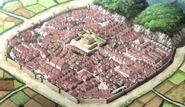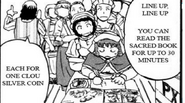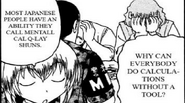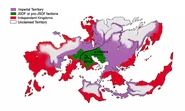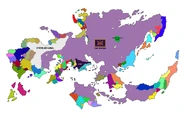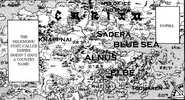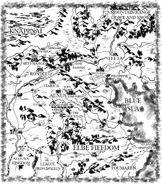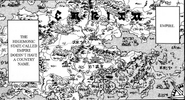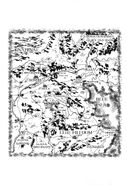The Empire (帝国 Teikoku), also known as the Saderan Empire, is a pre-industrial, militaristic, and autocratic state without an official name located in the Special Region and ruled by Emperor Molt Sol Augustus, where it runs in a hegemonic system with many vassal states. As an imperium dominatus it controls most of the continent of Falmart, ranging from the northern mountain ranges, south along the coast of the Blue Sea, and from the western desert regions to a mountain and forest regions far to the northeast, a total distance of about 8000 km. This impressive size means that the Empire is comparable in size to the real-world Mongol Empire, the largest contiguous land empire in history. The Imperial Capital, Sadera, is located northwest of Alnus and to the north of the Blue Sea coast.
After the Imperial Civil War with near-total devastation of the Imperial Army, the Empire officially loses its status Major Power. It enters a period of great decline in which it no longer holds great influence on the vassal states, and becomes vulnerable to foreign invasion within the Special Region for at least a century.
Politics
The Imperial government is nearly identical to the Roman Dominate Period (the ruling System of the Roman Empire in the late Antiquity from 284-630AD) in which the Emperor is nearly an absolute monarch. He has the responsibility for the overall policy of the state and its diplomacy and has the final authority on most matters of state. However, substantial power also lie in the hands of the Imperial Senate. Like in the Dominate, there exist the title of princess, which, in reality, never happened in the Roman Principate Period (the ruling System of the Roman Empire in the classic Antiquity from 27BC-284AD).
Like in the Late Antiquity Roman Empire, domestic affairs are still managed locally, by governors selected by the Emperor to administer domains on his behalf. In addition, the Empire has permitted certain cities with long and distinguished histories, such as Rondel and Bellnahgo, to rule themselves; this was typical for the Eastern Roman Empire since the 2nd half of the 5th Century. Certain places which are not suitable for a limited-term regional governor, but which require long periods of acclimation, such as House Formal’s domain, which counts many races and tribes among its denizens, have been ceded to individuals who possess the requisite adaptability. Many lesser kings and nobles swear loyalty to the Empire and provide troops during times of war whilst controlling most of the local affairs in their territories. Imperial vassal states included the Kingdom of Elbe, the League Principality, Kingdom of Mudwan, Kingdom of Alguna, and the city of Italica. In term of religion, the Emperor counted as the highest religious official in the Empire so he could speak with Apostles during national religious events.
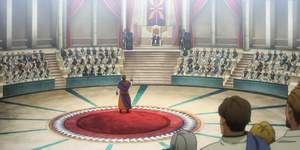
A session of the imperial senate after the outbreak of the Japanese-Empire War.
Like in the Late Antiquity Roman Empire, senators, military commanders, and other high-ranking officials carry substantial power; more than enough to depose an emperor if they oppose him. Molt Sol Augustus has many such enemies, as seen in Episode 2 when the Emperor orders his rivals to attack the Japan Self-Defense Forces encampment at Alnus, knowing full well they would be slaughtered by the superior firepower of the JSDF. He later orders the surrounding regions to be burnt down by applying scorched earth tactics, officially to deny the JSDF from obtaining local resources but it is totally useless due to the high mobility of modern vehicle and effective logistic line of the JSDF as well as the fact that Empire's conventional resources means little to none to the JSDF.
The behavior of the Senate and the Empire in general before their massive defeat by the JSDF are highly arrogant and chauvinistic since they often think the Empire is always unbeatable against any foes due to having rule their continent unopposed for 600 years. They also have the tendency to call others nations beside the Empire as barbarian much like the Ancient Greek from the Earth. This kinds of attitude also extends to Japan, despite Japan's vast superior technology and military. As the result, this attitude makes them unprepared to fight the technological superior of the JSDF causing them to suffer massive defeat and casualties.
After their extensive loss from fighting the JSDF, the politics of the Empire becomes more humble since the Empire acknowledges that there are enemies that are too powerful to fight continuously or defeat and sometimes peace through negotiation is the best way to ensure the existence of the Empire as well as the fact that there are civilizations that are far superior to them in every ways and the Empire is not the center of the world. However, some of the people like Zorzal and pro-war senators and generals don't think like the others sensible pro-peace senators in which they try their best to defeat Japan, defense their blind chauvinism and preserve the glory of the Empire for thousands of years by continuing to battle the JSDF, despite no matter how futile and idiotic is it.
After the Imperial Civil War and the closure of the Gate, with Zorzal's death and the collapse of the pro-war faction, the political system changed from monarchy to democracy to ensure a tyrant like Zorzal will never damage the Empire in the future. As the hopeless war costs the Empire almost all of it military power, Pina has to do what is considered to unthinkable for the Empire in their long history, which is personally going to several far away countries to pledge for peace agreement as the Empire is now too weak to even defend themselves from potential invasions. The situation is so dire that Pina has to rely on stranded JSDF personnel and Rory Mercury for protection against threats from within the Special Region for the sake of the Empire.
Taking advantage of the severely weakened Empire, King Elbe and others leaders of the former vassal states force Pina Co Lada to pay them tons of golds and surrender a lot of lands and mining areas for them as reimbursements for the great damages in their national military after the massacre of the Second Battle of Alnus Hill, which Molt tricked them into fighting the JSDF. Cope with the fact that Molt already surrendered a good amount of lands and mines to the JSDF to get rid of Zorzal and his pro-war faction, the Empire experiences massive economic downturn because of this.
History
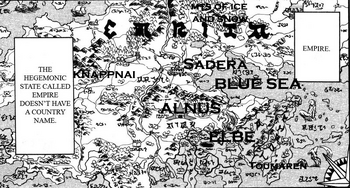
An annotated map of the Empire
Based on the Imperial Calendar, which likely marks the founding of the Empire as "Year 0", the Empire was presumably founded 687 years before the invasion of the JSDF, or in the early 1300s based on Earth's calendar. Initially the country was a democracy, however, the government grew ineffective as the territory increased, which resulted in the current imperial government. While few events in the history are known, it is known that, about 250 years prior to the JSDF arrival, or around 487 Imperial Calendar (mid-1700s), a major war called the Arctic War took place, which is generally considered to be one of the most turbulent and difficult times in Imperial history. In 680, a major rebellion occurred in the Empire. While little is known about the precise details of the rebellion, it can be surmised that it was crushed with brutal force. The crushing defeat in the Japanese-Empire War, which started in 687, or the early 21st century on Earth, led to the decline of Imperial power in the Special Region. By the end of the Imperial Civil War, the Empire loses 90% of its military and becomes the shadow of its former self. Pina Co Lada states that it will take a century for the Empire to recover. As the result, all vassal states and neighboring countries now don't have to fear the Empire anymore and most of the vassal states have successfully declare independence from the Empire.
Military
Main Article: Imperial Army
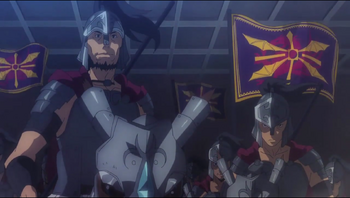
Imperial Army at the beginning of the battle of Ginza
The Imperial Army is similar in appearance and structure of the real-world Roman Army during its Imperial period, being made up primarily of formations of infantry armed with spears, swords, and large rectangular shields. Also present in the military are cavalries, archers, siege engines such as battering rams, ballistae, and trebuchets, and dragon riders. Auxiliary forces are provided by both human and goblin vassals of the Empire.
While the Empire is very Roman-like, their technology level is actually more late-medieval. For instance, the Imperial cavalry are typically similar in appearance to medieval knights, clad in plate armor and armed with swords and lances. Other medieval weaponry used by the Empire include halberds and trebuchets. The Empire had not yet invented gunpowder and therefore had never seen firearms or powerful explosives prior to first contact with the JSDF.
Magic exists in the Special Region, primarily in the form of manipulating other objects and forces, such as creating explosions, fire, or electrical discharges. However, it is not very powerful, mainly due to the lack of understanding of the forces they are attempting to manipulate. For instance, the Empire has no understanding of the chemistry behind combustion, and after Lelei La Lalena learns of this information from the Japanese, her fire magic becomes exponentially more powerful, finally becoming a viable weapon. Lacking such knowledge, the Imperial army does not typically employ sorcerers in battle, though they will employ magical creatures, primarily dragons to be used as mounts. On the rare occasion where magic is used on the battlefield, it is generally used for support purposes, as seen by Myuute Luna Sires use of wind magic to blow arrows off course.
Much like the Roman army, the largest division of troops is referred to as a legion. Other divisions of the army are not known and it is not clear how the size of an Imperial legion is comparable to that of a Roman legion from the Early Principate Period (2.000-5.000 man per Legion and 1.000-2.000 man auxillaries). It is also not clear whether auxiliaries and orders of knights are integrated into the legions or they exist separately. Auxilliariy forces are structured and fashioned in their own native ways like the foederati (regional recruited barbarian forces, lead by their own rulers) in Roman Armies of the late Antiquity.
Everything that has happened thus far has taken place on land, so there has been no contact with anything that resembles an Imperial Navy. Still, a map of the Special Region depicts a Greco-Roman-style warship or trireme like in the classic ancient period, a mixed oar and sail powered vessel armed with a forward naval ram. This suggests the Empire or their vassal states possess some form of naval forces.
Due to their primitive and inferior weaponry, they often rely on human wave attacks against modern firearms of the JSDF, which is prove unreliable overtime since the Empire will likely runs out of soldiers, centaur, and orcs as well as goblins to throw at the firearms of the JSDF. The only achievement for this ineffective tactic is they can only overwhelm a small squad of JSDF soldiers ranging from 10 to 20 members whilst suffering the loss of hundreds to thousands of Imperial soldiers.
After the Imperial Civil War, the Imperial Army loses 90% of their fighting power from excessive human wave attacks against JSDF firearms and armored vehicle to which they only have limited influence on the vassal states as well as the fact they no longer have the military power to threaten neighboring countries or vassal states.
Economy
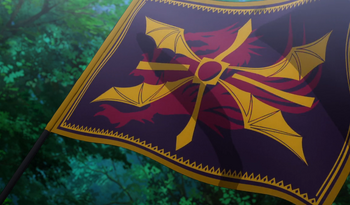
The Imperial Flag
The Empire is the dominant power on the continent of Falmart, and presumably possessing the largest economy with the capability to field a full-time professional army, as well as complete massive construction projects such as many of the grand buildings and statues in Sadera. In spite of this, the Empire's economy is limited by its pre-industrial technology level, which places severe limits on the amount of resources which can be exploited by the Empire, as well as the annual gross domestic product of the Empire. For this reason, the Empire's annual gross domestic product pales in comparison to that of a modern industrialized country such as Japan. While the annual GDP and government budget of the Empire is not known, it is known that the initial Japanese reparation demand of 500 million Suwani, which is about the same amount as the Japanese government's annual budget, was considered to be an outrageous sum where one member of the Senate's pro-peace faction mentioned that "all the money in the world would fall short of that amount."
As their non-industrialization suggests, the Empire's citizens create hand-made goods, which interest the people in Japan who are used to mechanized products. The lands of the Empire also have gold and silver, which are valuable both in the Empire and in Japan. One of the more unique materials in the Empire are winged dragon scales, which are sold for a large amount of money.
One particular element that should also be noted of the Empire's economy is one of its characteristics shared with ancient Rome: Slavery. It is not known whether the mechanics of slavery in the Empire are similar or not to those of ancient Rome but is known that in the Empire exists a market completely dedicated to the trade of slaves and that the slaves are used for forced labor and sexual exploitation in inhumane and life-threatening conditions. The enslavement of the war prisoners seems to be a widely accepted and deeply rooted custom of the imperial culture. The enslavement of war prisoners is considered by the imperial citizens, or at least by the imperial royalty, to be a part of the natural order of things: the victor decides the fate of the loser (a concept considered to be utterly abominable by a modern culture like that of Japan).
Education
The education in the Empire, at least compared to First World countries, is apparently very poor as commoners lack access to basic education where it is noted that Imperial Soldiers are incapable of doing mental calculations, thus they would be easily cheated by unscrupulous merchants during the Currency exchange; the JSDF soldiers would often surprise merchants, who usually require a tool to calculate even basic math.
While literacy rates are unknown, it is likely that they are very low, with literacy restricted mostly to members of the upper classes, who would have access to education, as well as to some professions which would require literacy. It's shown that some common people in the Empire seem to be literate, even servants such as Delilah. This suggests that literacy rate may be similar to those in the real-world Roman Empire- relatively high in comparison to other ancient cultures and the subsequent Middle Ages, but still considerable lower than the standards of modern developed countries.
Technology
The technology of the Empire and the whole Special Region is pre-industrial level in which the concept of science and technology is generally alien concepts to the average citizen as well as others races live in the Special Region. As the result, the Empire and Special Region's people and others races often regards high tech equipment and weaponry used by the JSDF as magic like the anti-tank rocket launcher is regard as Rod of Steel, firearms is regard as magic wand, camera is called magic box or vehicles are called steel beast. Furthermore, they also often misunderstand some certain utilization of technology by the JSDF as conducting magical rituals as the Dark Elves thinks the JSDF is performing magical rituals while they are firing artillery at the Flame Dragons or mispronounce the name of technological equipment or weaponry like the Dark Elves misspells C4 explosive as ''SeeFour'' or Zorzal and his general misspells the word Aeroplane as ''El Ro Plains''.
Furthermore, very few of the people of the Special Region interests in studying and reverse-engineering advanced technology of the JSDF due to their lack of awareness of the usefulness of science and technology or because of their own arrogance to state that technology is insignificant to take into consideration, especially Zorzal and his pro-war generals and senators who foolishly believes throwing soldiers with sword and shield against firearms can guarantee victories.
The city of Rondel is considered to the place in the Special Region where some scholars conduct conventional science research, despite they are unfamiliar with the concept of science and technology. However, it is shown that the mindset of the Empire's citizen still stuck in the Dark Age in which they rejects some discoveries of some of the scholar as heresy like the fact that the Earth rotates around the Sun or the Earth is actually sphere not flat much like Galieo being prosecuted for his theory by the Inquisition in the world beyond the age thousands years ago. Even Lelei admits that the citizen of the Empire is still too primitive to comprehend science and technology unlike the modern civilizations beyond the gate. As the result, Lelei feels hesitate to reveal the mechanism of gun power and explosion to the citizen since she thinks the Special Region's people is not ready to accept science and technology. Furthermore, the enforcement of the gods in limiting technological advancement also the Empire and the entire Special Region in general in the state of perpetual stagnation.
According to Akira Yaginada, the gap of technology between the Empire and the Earth civilization is far too great in which The Empire is seen as bug while the Earth civilization is seen as titan.
Notable Citizens
- Molt Sol Augustus
- Piña Co Lada
- Zorzal El Caesar
- Diabo El Caesar
- Casel El Tiberius
- Herm Fule Maio
- Godasen
- Podawan
- Colt Formal
- Beefeater E Caty
- Bozes Co Palesti
- Grey Co Aldo
- Hamilton Uno Ror
- Norma Co Igloo
- Panache Fure Kalgi
- Marquis Calasta
- Shandy Gaff Marea




